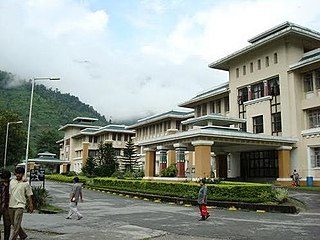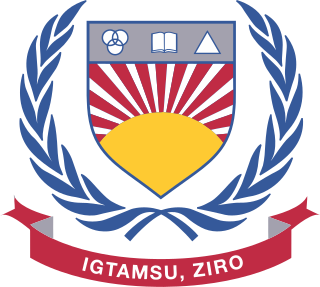Related Research Articles

Madan Mohan Malaviya University of Technology, Gorakhpur (MMMUT) is a university in Gorakhpur.
Deemed university, or deemed-to-be-university, is an accreditation granted to higher educational institutions in India by the Department of Higher Education. To quote the Ministry of Education (MOE), "An Institution of Higher Education, other than universities, working at a very high standard in specific area of study, can be declared by the Central Government on the advice of the University Grants Commission (UGC), as an Institution 'Deemed-to-be-university'. Institutions that are 'deemed-to-be-university' enjoy the academic status and privileges of a university."

The University Grants Commission of India is a statutory body set up by the Department of Higher Education, Ministry of Education, Government of India in accordance to the UGC Act 1956 and is charged with coordination, determination and maintenance of standards of higher education. It provides recognition to universities in India, and disbursements of funds to such recognized universities and colleges. The headquarters are in New Delhi, and it has six regional centres in Pune, Bhopal, Kolkata, Hyderabad, Guwahati and Bangalore. A proposal to replace it with another new regulatory body called HECI is under consideration by the Government of India. The UGC provides doctoral scholarships to all those who clear JRF in the National Eligibility Test. On an average, each year ₹725 crore (US$96 million) is spent on doctoral and post-doctoral fellowships by the commission.
Department of Higher Education is the department under Ministry of Education, that oversees higher education in India.

Central universities or union universities in India are established by an Act of Parliament and are under the purview of the Department of Higher Education in the Ministry of Education. In general, universities in India are recognised by the University Grants Commission (UGC), which draws its power from the University Grants Commission Act, 1956. In addition, 15 Professional Councils are established, controlling different aspects of accreditation and coordination. Central universities, in addition, are covered by the Central Universities Act, 2009, which regulates their purpose, powers, governance etc., and established 12 new universities. As of 31 March 2021, The list of central universities published by the UGC includes 54 central universities.

Vinoba Bhave University is a state university located at Hazaribagh, Jharkhand, India, about 100 km from Ranchi, the state capital. The university offers courses at the undergraduate and post-graduate levels, manages and maintains 12 constituent colleges. 61 affiliated colleges are also imparting teaching up to undergraduate level in physical science, life science, earth science, social science, humanities, commerce, technology, medical science and in law, education, homeopathy and ayurvedic medicines. The university came into existence on 17 September 1992 as a result of the bifurcation of Ranchi University.
The Ministry of Education (MoE), formerly the Ministry of Human Resource Development (1985–2020), is a ministry of the Government of India, responsible for the implementation of the National Policy on Education. The Ministry is further divided into two departments: the Department of School Education and Literacy, which deals with primary, secondary and higher secondary education, adult education and literacy, and the Department of Higher Education, which deals with university level education, technical education, scholarships, etc.
Section 96 of the Constitution of Australia authorises the Australian (Commonwealth) Parliament to grant financial assistance to any state on the terms and conditions that it sees fit, subject to acceptance by the state(s) concerned. The expanded use of the power under section 96 has added to Australia's vertical fiscal imbalance and enabled the Commonwealth to have a significant influence over matters that would otherwise be constitutionally State responsibilities.

The higher education system in India includes both private and public universities. Public universities are supported by the Government of India and the state governments, while private universities are mostly supported by various bodies and societies. Universities in India are recognized by the University Grants Commission (UGC), which draws its power from the University Grants Commission Act, 1956. In addition, 15 Professional Councils are established, controlling different aspects of accreditation and coordination. Private universities in India are regulated under the UGC Regulations, 2003. Per the UGC act and these regulations, private universities are established by an act of a local legislative assembly and listed by the UGC in the Gazette upon receiving the act. As confirmed by ruling of the Supreme Court of India, recognition by the UGC is required for the university to operate. Also, per the 2003 regulations, the UGC sends committees to inspect the private universities and publishes their inspection report.

GLA University is a private university in Mathura, Uttar Pradesh. It has been declared fit to receive central assistance under Section 12B of UGC Act, 1956 after proper assessment for the same by the UGC. It is recognized by University Grants Commission (UGC), NCTE and Pharmacy Council of India. It has been accredited by the National Assessment and Accreditation Council (NAAC) with ‘A’ Grade.
India has the largest numbers of engineers as well as the largest number of engineering education institutes and infrastructure in the world. As of 2021, India annually produces one million engineering graduates. India's technical education infrastructure includes 3500 engineering colleges, 3400 polytechnics and 200 schools of planning and architecture.
Rashtriya Uchchattar Shiksha Abhiyan (RUSA) is a holistic scheme of development for higher education in India initiated in 2013 by the Ministry of Human Resource Development, Government of India. The centrally sponsored scheme aims at providing strategic funding to higher educational institutions throughout the country. Funding is provided by the central ministry through the state governments and union territories (UT), which in coordination with the central Project Appraisal Board will monitor the academic, administrative and financial advancements taken under the scheme. A total of 316 state public universities and 13,024 colleges will be covered under it.

Maulana Abul Kalam Azad University of Technology (MAKAUT), formerly known as West Bengal University of Technology (WBUT), is a public state university located in Kalyani, West Bengal, India. It is funded completely by the Government of West Bengal. It was established in 2001 by the West Bengal legislature. The university provides management and engineering degrees through affiliated colleges and in-house departments.

Indira Gandhi Technological and Medical Sciences University (IGTAMSU), is a private university located in Ziro, Arunachal Pradesh providing higher education in nursing, yoga, paramedical, physiotherapy, management, law. The University was established in 2012, when the Legislative Assembly of Arunachal Pradesh passed Indira Gandhi Technological And Medical Sciences University Act 2012. The Indira Gandhi Technological And Medical Sciences University is accredited and recognized by the University Grants Commission under the section of 2(f) of UGC Act 1956.
References
- ↑ "Seventh Schedule- Constitution of India" (PDF). Ministry of Law and Justice (India). p. 276. Archived from the original (PDF) on 21 April 2015. Retrieved 27 June 2015.
- 1 2 "List of State Universities as on 17.05.2021" (PDF). University Grants Commission. 17 May 2021. Retrieved 30 June 2021.
- ↑ "University Grants Commission Act, 1956" (PDF). Union Human Resource Development Ministry . Retrieved 4 March 2020.
- ↑ "Decision by the Commission". ugc.ac.in. University Grants Commission . Retrieved 1 July 2017.
- ↑ "List of State Universities which are included under Section 12(B) of the UGC Act, 1956 and are eligible to receive Central assistance (As on 17.05.2021)" (PDF). University Grants Commission. 17 May 2021. Retrieved 30 June 2021.